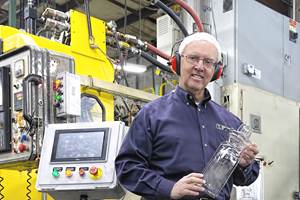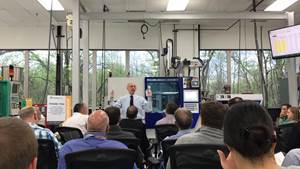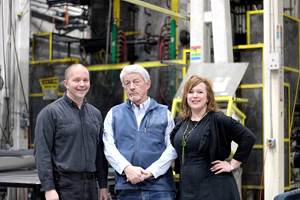Training Pays Off in Productivity
A skilled and efficient workforce provides a decisive edge against competition and improves the bottom line.
A skilled and efficient workforce provides a decisive edge against competition and improves the bottom line. That philosophy is showing results at Plastikos Inc. in Erie, Pa., a $17-million custom injection molder serving electronics, medical, automotive, telecommunications, and defense customers since 1989. Plastikos is one of the first injection molders in the U.S. to adopt the British-developed Global Standards for Plastics Certification (GSPC) training program. “GSPC provides tremendous value in our efforts to continually improve our position as a world-class supplier of close-tolerance, highly engineered components,” says Philip A. Katen, general manager. GSPC allows the employer to create and implement customized training, which makes it more useful than other plastics certification programs, in Katen’s view.
The company has 100 employees and 26 presses from 25 to 130 tons. It molds 150 million parts per year from LCP, PEI, PEEK, and other engineering resins. Plastikos specializes in small, complex, precision parts with critical dimensions. A typical example is an electronic connector having pockets measuring 0.016 x 0.016 in. or smaller with tolerances of ±0.0005 in. or less.
Plastikos is geared to short runs: “On any given day, it is not unusual for us to execute 15 to 40 changes of tools or tool inserts, with some machines having up to six changeovers in a day,” says Katen.
TRAINING PAYS OFF
The combination of multiple tool changes, expensive resins, and extremely fine part tolerances led Plastikos to modify its training approach. Some new employees did not have a strong grounding in basic machine operation or quality procedures. In one shift, a worker would mold a product one way, then the person following in the next shift would do it completely differently. The lack of uniform training produced inconsistent machine setups, higher scrap rates, longer changeovers, additional quality checks, more frequent maintenance, and lower throughput.
Since implementing GSPC training last Fall, Plastikos has seen scrap rates drop by at least one-third, total efficiency improved 15% to 20%, downtime was cut 30%, and start-ups are 20% to 30% more successful. “GSPC helps us get all employees up to speed more quickly and uniformly,” says Katen. “Turnover in our lower-skilled positions has dropped significantly.”
BRITISH IMPORT
The GSPC program started 14 years ago in the U.K., and is administered here through Mid-America Plastic Partners Inc. (MAPP), an Indianapolis-based self-help organization of plastics processors. Assistance in GSPC implementation came from the Pennsylvania College of Technology in Williamsport, Pa. MAPP and Penn College are implementing GSPC at 19 U.S. molding plants, of which Plastikos is so far the most successful.
GSPC owes much of its format to A. Routsis Associates Inc., Dracut, Mass., the primary supplier of the basic training materials. The program has three certification levels: Level I covers general and overall knowledge of the molding plant. Level II brings a more focused and sophisticated understanding of the production process and the ability to monitor and maintain quality. Level III conveys in-depth knowledge of injection molding and special techniques such as insert or multi-shot molding. Katen says Level III is similar to the Routsis Master Molder training program.
Users can bring custom content to the training at all levels. Plastikos developed customized mold-change training for faster setups and will look at training in machinery automation next. With customized training, the firm has been able to bring welding and laser-engraving operations in-house.
Each program level involves classroom work and hands-on learning on the plant floor. Users progress at their own speed, gauged by frequent testing. Plastikos hopes to have every employee Level I certified, 10% certified at Level II, and 1% at Level III.
Related Content
Plastics Processors Who Hire ‘Second-Chance’ Workers Do Well by Doing Good
Two blow molders with long-standing programs of hiring formerly incarcerated low-level offenders have helped these individuals re-enter their communities and have benefited from an additional resource during chronic labor shortages.
Read MoreThe Experience Curve and Well-Trained Process Technicians
Pairing external big picture training with internal job-specific instruction can help your process technicians meet quality expectations as well as production targets.
Read MoreThe Cost of High Employee Turnover in Injection Molding: Why Retention Matters
Starting in molding in 1993 and clocking in for nearly every job on the floor over the intervening decades, I’ve seen all sides of the hiring, training and retention process in the industry. Here are my thoughts on how to keep your most important asset — your people.
Read MoreBlow Molder Confer Plastics Celebrates Golden Anniversary & the ‘American Dream’
This family-run firm fills a specialized niche with a culture of innovation and environmental stewardship that realizes the dreams of its founders, its employees and its customers.
Read MoreRead Next
People 4.0 – How to Get Buy-In from Your Staff for Industry 4.0 Systems
Implementing a production monitoring system as the foundation of a ‘smart factory’ is about integrating people with new technology as much as it is about integrating machines and computers. Here are tips from a company that has gone through the process.
Read MoreMaking the Circular Economy a Reality
Driven by brand owner demands and new worldwide legislation, the entire supply chain is working toward the shift to circularity, with some evidence the circular economy has already begun.
Read More












